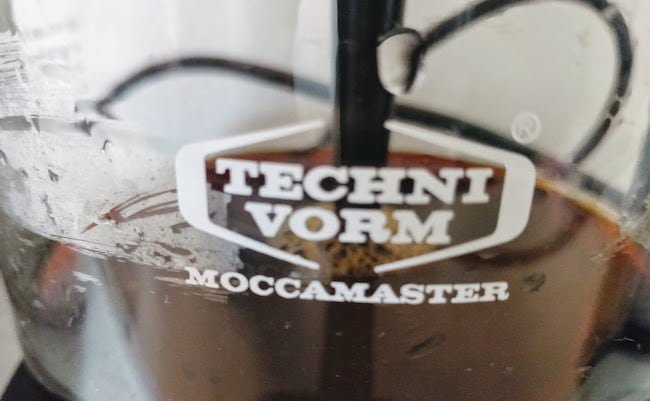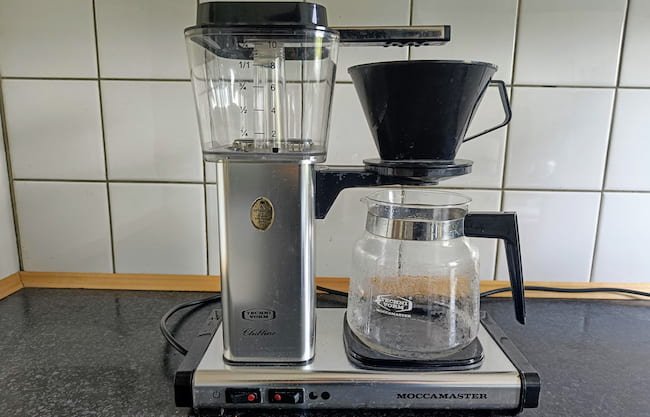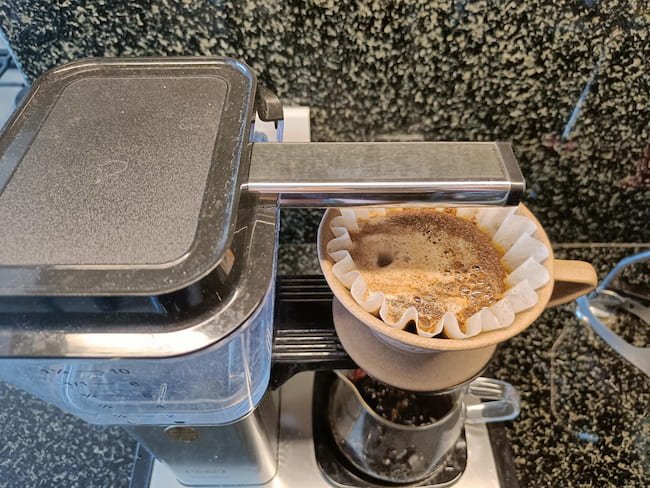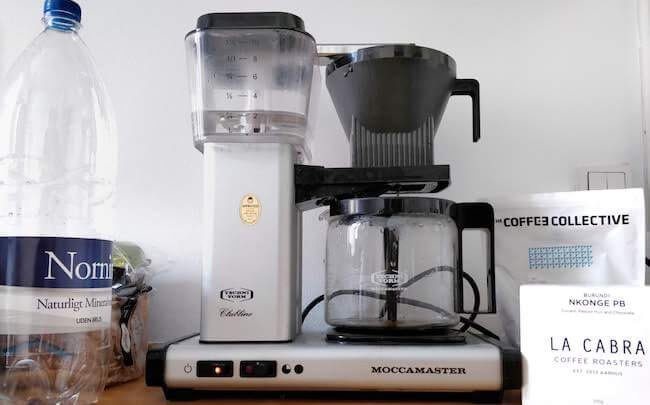During my childhood in Denmark, I saw a lot of Moccamasters. They were in kitchens everywhere. Even my grandmother had one.
(Allegedly, my granddad had bought it for her since it brewed way faster than other coffee makers!)
But all this was long ago – way before the specialty coffee revolution was kicked off in the mid-’00s. The Moccamaster was designed in the 1970s and has barely changed since then.
So all this made me curious to see whether this iconic coffee machine still has what it takes.
I tested the Moccamaster for over a month and brewed coffee on it daily.
Read on to see whether this device is worth the money for modern coffee snobs.
Who is Technivorm?
Technivorm is a Dutch company that traces its roots back to the early 1960s. The company produced both a coffee maker and a grinder before eventually developing the now iconic KGB model in 1974.
Even though Moccamaster produces many different domestic models today, they are more or less just variations on the same theme.
Sure, some of them have thermal carafes, and some have a drip-stop function built into the filter-basket; however, essentially, they are all cut from the same cloth.
This is a refreshing approach when considering consumer electronics or high-street fashion. A Moccamaster from 25 years ago and today are virtually the same.

The materials and construction also follow the same eco-friendly ethos. The housing is made of a sturdy aluminum block, and most (if not all) parts are available as spare parts.
So let’s say you have a problem with your carafe or water spray arm. In that case, buying a new part and replacing it yourself will be simple. That’s what I did in the case of the water outlet arm. But more about that later.
Technivorm also still has a factory in the Netherlands, where the machines are assembled by hand. This also explains why the Moccamasters are more expensive than companies based in Asia. Although, the brand is not crazy expensive in the EU. However, it’s more of an investment in the US and other parts of the world.
Moccamaster Glossary
There are a lot of minor variations among the Moccamasters. The abbreviations in the name give away all the small details:
KBG: The classic model
KB: The classic model but without the auto-drip stop-function.
KBT: The thermal carafe version
KBGV: The V stands for volume control. This model is also known as Moccamaster Select, and it’s the most updated version from 2021
HB & HBG – The models that start with “H” only have one heat plate setting. Not a big deal for most modern users.

Moccamaster KbG 741 in daily use?
Now, let’s forget about nostalgia and instead focus on how the Moccamaster performs today. Does it have what it takes?
As a coffee geek and Q grader with a massive brew device collection encompassing everything from Harios and Kalitas to PID-controlled espresso machines, I must admit I have high standards.
Could a 46-year-old design earn a place in my collection of coffee gadgets?
Initially, the workflow seemed a bit annoying with the different parts that had to be put in place.
Especially the removable lid on the filter basket and water reservoir seemed a bit annoying at first.
However, my experience has taught me that most coffee gadgets can feel that way at first, and then after a week’s use, muscle memory kicks in, and workflow issues seems like less of a big deal.
This also seemed to be the case here.
Also, the modular design makes the device easy to repair in case of problems.
The design wouldn’t have been around this long if it wasn’t solid.
Another significant aspect of the Moccamaster KBG’s design is that it’s straightforward to clean all parts correctly. One of the main problems with automatic drip coffee makers is that rancid coffee oils and mold will accumulate and affect flavor – and maybe even your health.
I never had any concerns in that direction when using the Moccamaster. All parts that are in contact with water and coffee grounds are easy to access and clean. The only exception is the water reservoir – when it comes to the water tank, it’s essential to pour fresh water into it. And don’t use the carafe to fill it since you might have some coffee oils still stuck there.
Extraction issues?
The next test was to brew some proper coffee. In the period I was testing the Moccamaster, I mainly was brewing for just two persons. A huge batch is a bit too much for two people, so I was brewing two large mugs worth of coffee most of the time. So that was typically around 500 ml’s to 32 grams of coffee.
The resulting brews were a bit too fast if I didn’t do anything to slow them down. This makes sense as Moccamaster has a reputation for brewing quickly. However, I didn’t quite get the contact time I was looking for. This is probably due to having a large basket optimized for big brews combined with a fast water flow.
I often found myself turning off the machine for 30 seconds after the first water had been dispersed to mimic a bloom. This improved the extraction and resulted in rounder and more full-tasting cups.
If you just let the water pump run freely without any intervention, it will run 500 ml in two minutes. After that, your grind size will dictate the total brew time. In most cases, that will result in a brewing time of around 2.30 minutes. A bit too fast, if you ask me.
The new Moccamaster outlet arm

Another issue I encountered was a too narrow water dispersion. The Moccamaster uses a long and narrow water spray arm. However, due to the design of the nine holes in the arm, the water tends to run together to form a single stream. This powerful stream would dig into the brew bed and produce a giant crater in the middle. Being used to brewing pour over coffee, I know that this is not good. Instead, you want an even dispersion over the whole bed of coffee. Ideally, you also aim for a relatively gentle flow that doesn’t churn up the entire brew bed since too much agitation can create bitterness in the cup.
While researching the issue, I found out that the most recent generation of Moccamaster ships with a slightly redesigned water outlet arm. On this spray arm, the holes have a sort of protruding rib that encourages even dispersion across the whole surface. So I found an online shop and ordered a new water outlet, which only set me back something like $28-30.
Installing the new arm was so simple that even a child could do it. A few minutes after receiving the replacement, my brew bed looked significantly better and had that slightly more soft texture indicating a more gentle agitation.

Can it brew proper coffee?
Overall, the coffee from the Moccamaster tasted excellent. The company has done a fantastic job of getting the right temperature. The machine uses a copper heating element. Allegedly, it’s of higher quality than other manufacturers, but I don’t have a way to verify this claim. However, the Moccamaster is a SCAA-certified coffee maker, so it’s safe to assume that it brews at the right temperature.
If you have clean water at the correct brew temperature (around 93-95 C), poured at the correct intervals, spread across the brew bed evenly, then the resulting coffee will taste good. That’s just a basic coffee fact.
However, most of the time, I was helping the Moccamaster a little bit along during the process. As mentioned, I would often add a “blooming phase” by switching off the machine. I would sometimes use a spoon to stir the brew bed. Or I would move the spray arm slightly at an angle to ensure even saturation.
These steps seem necessary to get the best out of the machine. If you don’t do it, you’ll still get good coffee, but maybe you’ll only reach 80%, while the small hacks can help you get the last bits out of your beans.
In a sense, it’s a bit of a shame that you have to do something like that with an automatic drip coffee maker since that kind of goes against the whole philosophy. But, on the other hand, these are small steps to ensure fantastic coffee on a large scale. And they will become second nature rather quickly.
Moccamaster for geeks?
Being a hardcore coffee geek, of course, I couldn’t resist making things even more advanced.
I tried using different brewers instead of the cone-shaped basket, and you can get quite interesting results by using a Hario V60 or Kalita Wave instead of the original basket. The filter holder is almost perfect for one of those devices.
If you’re even more ambitious, it’s relatively easy to take out the two screws and remove the filter holder. Then you’ll be able to fit larger brewers in there—for example, a Chemex or Hario Nel Dripper.
My best results with all these experiments came when using a Kalita Wave and Gabi Dripmaster B together. To my surprise, the coffee turned out velvety and well-extracted when brewing 500 ml’s at a 1:16 ratio.

Who is it for?
The big question and why you’re reading this article is that you’re considering whether you should get the Technivorm Moccamaster.
I think it depends on who you are and what your coffee needs are.
If you’re a specialty coffee geek who is mostly brewing a two-cup Hario V60 at most, I don’t think there’s a compelling reason to involve a machine.
Convenience? Not really. Most of the time, it will be just as easy to brew some pour over coffee.
Quality? No. When executed perfectly, pour–overs still have a tiny edge in quality over drip coffee makers.
The proposition changes if you are often brewing bigger batches, i.e., 4-10 cups.
In that case, I think the Moccamaster makes a lot of sense. You can make a big batch of coffee for your friends and family and be confident that it’s delicious.
Plus, you don’t have to be very involved during most of the brew cycle. You can grind coffee and prepare the machine, which takes 1-2 minutes, and then you can focus on your guests for the remainder of the brew cycle.
What if you’re just an average person who wants an iconic coffee maker in your kitchen?
Well, I think again the Moccamaster makes a lot of sense. Yes, it is two-three times more expensive than comparable drip coffee makers. However, in terms of build quality, it will also last at least that long. So from a long-term financial standpoint, it’s not a silly investment. Especially not if you’re a person who cares about sustainability. Then a single, repairable device is always better than buying several cheap ones.
Drawbacks of the Moccamaster KBG
There are a few downsides to the Moccamaster, especially to the classic KGB 741, but those depend slightly on each model.
Let’s address them here:
- Poor spray arm: This was the case on all older models, but Moccamaster will transition to the new design going forward. However, I’m sure many models out in stores still have the old water outlet design. If you want to get the correct model, go for the brand new Moccamaster “Select” model.
- Heat Plate: Most Moccamasters have a heat plate. If you’re old school, you might like that. However, most modern coffee snobs don’t care much for this feature. If you remove the coffee when the brew cycle has finished, it doesn’t hurt the brew, as far as I can tell.
- Fast Brewing: You can turn off the machine for 30 seconds after the brew bed has been saturated, but of course, this feels like a slightly low-tech solution. Again, the newest version, the Moccamaster Select, has a feature that will slow down the flow rate and help extraction when brewing smaller batches.
- Flimsy Carafe: On such a premium device, the carafe is the biggest letdown. It’s thin and fragile. In addition, the handle is a bit flimsy. I have gotten used to premium servers from Hario, Kinto, and Kalita, so it feels a bit underwhelming. However, this is not a big deal. You can easily use other brands if it annoys you too much.
Overall, many of these cons are fixed if you go for the thermal carafe version or the brand new Moccamaster Select. However, the unit I used for this review is the most basic KGB 741; the drawbacks didn’t ruin the experience. You can work around most of them.
Alternative Drip Coffee Makers?
The obvious alternative to the Moccamaster is the Breville Precision Brewer, which I have previously reviewed. In many ways, these two coffee makers are opposites. The Breville device is highly advanced and adjustable, but also totally impossible to repair yourself in case you have any issues.
With the Breville Precision Brewer, you have temperature and flow control, and two different baskets, depending on serving size. So if you’re an extreme power user (somebody who knows what they are doing when it comes to extraction yield, TDS, and so on) and you must make HUGE batches (like 14-16 cups), then you can get something unique out of the Precision Brewer.
However, most normal people who brew between 0.5 l-1 liter (4-8 cups) most of the time have some excellent arguments for the Moccamaster.
If you use it the most straightforward way, it will make proper coffee. However, you can go a bit more “advanced” if you want to – stirring, pausing, or even experimenting using different baskets – for instance, a Hario V60 or Kalita Wave.
Verdict: Is the Moccamaster worth it?
The Moccamaster KBG 741 is a classic design in the world of coffee. It’s an old-school favorite like Levi’s 501’s or Converse sneakers.
In that sense, you intuitively know that it will work pretty well. However, as a specialty coffee geek, I was surprised to see that it met many of my needs. The last coffee maker I tested was the much more advanced Breville Precision Brewer, but I can’t say that I particularly missed many of its features when using the old-school rival.
Especially when it’s helped a bit on the way, the Moccamaster makes every bit as good coffee.
The classic KGB 741 is a little bit old-fashioned in a few ways, but it looks like Moccamaster has managed to address these issues with the new and upgraded Select model.
If you’re a coffee snob who wants to brew big batches with style, you can trust the Moccamaster as your daily driver.
Where to buy?
➡️ Amazon


